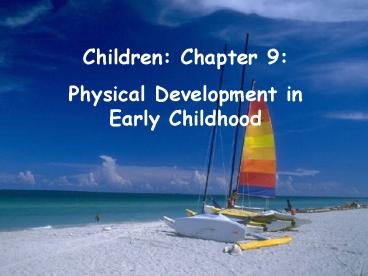LIFESPAN DEVELOPMENT - PowerPoint PPT Presentation
1 / 25
Title:
LIFESPAN DEVELOPMENT
Description:
Average child grows 2 inches and gains between 5 and 7 ... Strings 10 beads. Copies figure X. Opens and places. clothespins (one- handed) Builds a 5-block ... – PowerPoint PPT presentation
Number of Views:64
Avg rating:3.0/5.0
Title: LIFESPAN DEVELOPMENT
1
Children Chapter 9 Physical Development in
Early Childhood
2
Height and Weight
- Average child grows 2½ inches and gains between 5
and 7 pounds a year during early childhood - Growth patterns affected by genetics, growth
hormones, environmental factors - Boys gain muscle, girls gain fatty tissue
3
The Brain
- Brain and head fastest growth in body
- 75 of adult size by age 3
- 90 of adult size by age 5
- Neuronal Changes
- Myelination nerve cells insulated
- 36 age period dopamine increase
4
Structural Changes in the Brain
- Brain undergoes dramatic anatomical changes
between ages of 3 and 15 - Some areas almost double in size, purge of
unneeded cells follows (up to age 4) - Frontal lobe growth (36 years of age)
- Temporal and parietal lobes (6puberty)
5
The Brain and Cognitive Development
- Neural networks visual input is coded output is
language - Prefrontal cortex
- Dopamine key to information transmission in
prefrontal cortex and neural circuit - Important in self-control and other skills
- Preschool depth perception is maturing
6
The Prefrontal Cortex
7
Vision
- Regular vision screening before age 3
- Visual problems
- Unusual appearance of eyes
- Treatment before age 6 prevents vision loss
- Functional amblyopia imbalance, lazy eye
- Strabismus misalignment of eyes
8
Gross and Fine Motor Skills
- Preschooler highest activity level of any age in
the life span - Need daily exercise good programs with
creativity and free movement - Exercise increases physical and visual awareness
9
Gross Motor Skills
- Age 3 Enjoys simple movements such as hopping,
jumping, and running - Age 4 Becomes more adventurous and climbs
- Age 5 Runs hard, is adventurous, tries
hair-raising stunts in climbing
10
Fine Motor Skills
- Age 3 Still emerging from infant ability to
place and handle things - Age 4 Coordination improved and more precise
- Age 5 Hand, arm, and body move together under
better eye command
11
Development of Fine Motor Skills in Early
Childhood
Listed in approximate order of difficulty in each
period
12
Young Childrens Artistic Drawings
- Unintended irregularities suggest spontaneity,
freedom, and directness - Art provides hands-on approach to problem-solving
skills reinforces ideas of scale, space, motion,
distance
13
Stages of Young Childrens Artistic Development
14
Origin and Development of Handedness
- Genetic inheritance
- Right-handedness dominant in all cultures
- Hand preference may occur in womb
- Many preschoolers use both hands preference
develops later
15
Handedness, the Brain, and Language
- Approximately 95 of right-handed individuals
process speech primarily in left hemisphere - Left-handed individuals
- About 66 show speech and language in left
hemisphere - Show more variation in processing
- More likely to have reading problems and Learning
disabilities
16
Handedness and Other Abilities
- Left-handers more common among
- Mathematicians
- Musicians
- Architects
- Artists
- 20 of top-scoring SAT group were left handed
17
Sleep and Sleep Problems
- Most young children sleep through night
- Transitional objects
- Link between sleep and behavioral problems
- Nightmares frightening dreams
- Night terrors sudden arousal, intense
- Somnambulism sleep walking
18
Nutrition
- Energy/calorie needs increase with age
- Diets should be well-balanced
- Avoid excessive fast food, fat, and sugar
19
Sweets, Snacks, and Fussy Eaters
- Many eating problems carry over from toddler
years - Allow child to eat in any order/combination
- Let meal end when child has had enough
- Keep mealtimes enjoyable
- Dont use food as reward, punishment, bribe, or
threat
20
Obesity in Young Children
- Percentage of obese children increasing
- Encourage child to make independent and better
choices - Childhood obesity affects health problems
- Center life around activities, not meals
- Obesity linked to self-esteem
21
Malnutrition in Young Children from Low-Income
Families
- Malnutrition linked to many aspects of
development - Iron deficiency anemia
- May be linked to cognitive deficits
- Underfed children tend to receive less
supervision, stimulation, education - Linked to aggressive, hyperactive behavior
22
Preventing Childhood Injuries
- Accidents are leading cause of death in children
ages 1 through 4 - Many injuries can be prevented
- Always use car seats
- Lock up guns
- Childproof home and playground
- Better construction of playground equipment
23
Main Causes of Death in Children 1 Through
4 Years of Age
24
Contexts of Young Childrens Health
- Poverty a special concern
- Safety at home and in child care
- Childs lack of maturity in communication and
coping skills - Parenting strategies and medical treatment
25
- Environmental tobacco smoke
- Physical effects on children
- Exposure to Lead
- 3 million children under age 6 are at risk
- Cognitive deficits and ADHD






![[PDF] Growth and Development Across the Lifespan 3rd Edition Ipad PowerPoint PPT Presentation](https://s3.amazonaws.com/images.powershow.com/10079281.th0.jpg?_=20240716061)
























